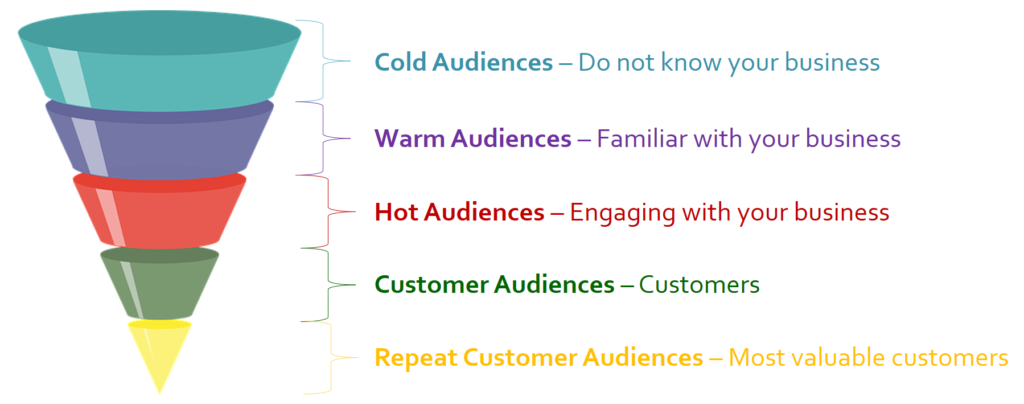During a crisis, your email communication can make or break your business. Even more importantly,...
The Key to Success with Facebook Ads: Audience Temperature
Audience temperature is arguably the most important targeting variable that many businesses ignore when creating Facebook Ad campaigns.
It’s easy to ignore because there are no options to select the audience temperature as you’re building your campaign. It’s not quite as simple as choosing your age range and gender.
Unfortunately, when you get this wrong, then your campaigns are destined to fail. Worst of all, it’s not clear exactly why you’re campaigns are failing unless you understand this critical factor.
What Is Audience Temperature?
The good news is that you likely already understand audience temperature — it’s basic Marketing 101.
As of writing this article, there are over 2.6 billion monthly active Facebook users, but obviously, not all of those users are prospective customers.
To be a prospective customer, the Facebook user needs to meet certain criteria with regards to demographics. Plus, you can home in further by selecting relevant interests and behavioral targeting options.
This is just one dimension of targeting. If you’re an engineering geek like me, then you can picture a two-axis graph where one axis is the measure of how close the Facebook user matches your ideal prospect characteristics (aka your customer persona).
The goal of this first axis is to select Facebook targeting options so that your ads are getting in front of your ideal prospects. I’m sure this is nothing new and most businesses do a fairly good job with this.
However, there is a second targeting dimension (or axis) that I call “Audience Temperature.” This is the measure of the prospective prospect’s awareness of your business and the desire to purchase. We use temperature as the measure because you’re probably already familiar with the concept of “cold” vs. “hot” leads.
Below is a visual of the different audience temperatures you can target.

Use Audience Temperature To Create Campaign Structure
Now that you understand the concept of audience temperature, it’s time to put it to use to improve your Facebook Ads campaigns.
The first step is to use audience temperature to create structure in your Facebook account. This isn’t required for success, but it certainly helps make your Facebook Ads account more manageable and easier to optimize.
To do this, simply organize your campaigns by the different audience temperatures defined in the visual above. For example, I strongly recommend separate campaigns targeting Cold audiences vs. Warm audiences vs. Hot audiences vs. Customer audiences vs. Repeat Customer audiences.
Most importantly, this will help you manage your budgets across these audiences since you likely don’t want to invest equally across those different types of audiences. Clearly, you’ll get more bang for your budget by targeting hot prospects that are already engaging with your business versus cold audiences that have never heard of your business.
Plus, there’s one more key benefit of using audience temperature…
Match Goals & Tracking to the Audience Temperature
I’m sure the overarching goal of your Facebook Ads campaigns is to drive leads and sales. That’s everyone’s goal.
It’s like saying my goal this year is to run a faster marathon. Yes, that’s my goal, but what is the goal when I’m stretching? And how do you measure speed increases when stretching? Clearly, when I’m stretching I can’t measure the quality of the stretch using the same metrics that I would use to measure my overarching goal.
Stretching in this example is just one piece of the larger training plan and it requires different goals and different measurements to gauge success.
The same is true with your Facebook Ads. Your goal is leads and sales, but you can’t measure the success of your Cold Audience campaigns using these metrics. That’s because you’re not likely going to generate many leads or sales from your Cold Audience campaigns — and that’s OK!
The goal of your campaigns is to move prospects down the funnel from “Cold” to “Warm,” then “Hot,” and eventually to the “Repeat Customer” audience. To measure the effectiveness of each campaign, here are some of the metrics you should track:
- Cold and Warm Audiences – Track engagement metrics like clicks to your website, video views, event RSVPs, and free offer requests.
- Hot Audiences – Track leads and sales.
- Customer and Repeat Customer Audiences – Track repeat sales and upsells.
See how your goals and tracking change depending on audience temperature? This is a critical concept to master so that you’re making smart decisions for each campaign.
Remember, just because a campaign isn’t driving leads or sales doesn’t mean it’s failing. That’s like measuring running speed while you’re stretching and getting frustrated that the stretch isn’t working! 🙂
fuente: https://www.mainstreetroi.com/the-key-to-success-with-facebook-ads-audience-temperature



